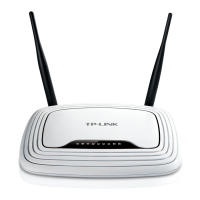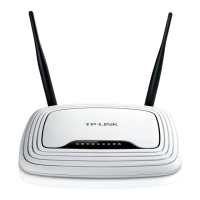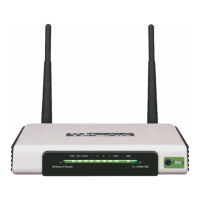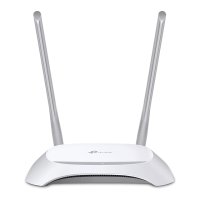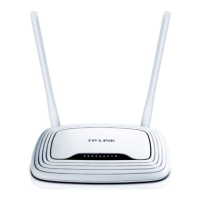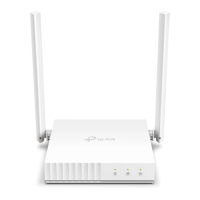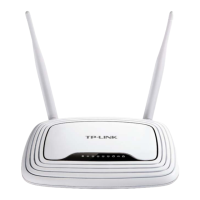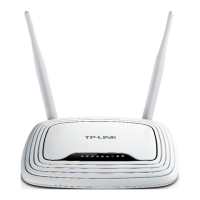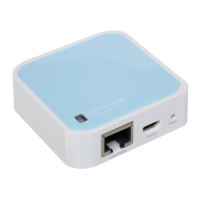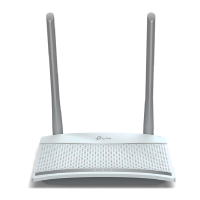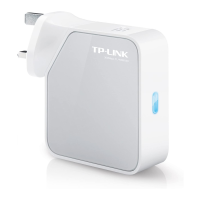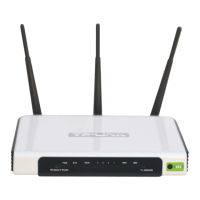Do you have a question about the TP-Link TL-WR841HP and is the answer not in the manual?
Describes the router's integrated features, speed, security, and ease of use.
Explains how product names are referred to in the guide.
Lists the router's key features like wireless speed, ports, security protocols, and modes.
Details the physical components and indicators on the router's front and rear panels.
Lists the necessary hardware and software for internet connection setup.
Provides guidelines for optimal router placement and operating conditions.
Provides steps for initial router connection and configuration.
Instructions for accessing the router's web management interface.
Configures internet connection types like Dynamic IP, Static IP, and PPPoE.
Configures basic wireless network settings like SSID and password.
Configures the DHCP server settings for automatic IP address assignment.
Manages network services like Virtual Servers and DMZ for traffic redirection.
Configures firewall, VPN, and advanced security settings for network protection.
Restricts internet access for specific PCs based on time and website.
Defines and manages rules for controlling internet access based on various criteria.
Sets overall bandwidth limits for upload and download speeds.
Provides tools for router management like firmware upgrade and factory defaults.
Guides on logging in and switching the router to Range Extender mode.
Displays the current operational status of the router in Range Extender mode.
Sets up the wireless network name (SSID) and mode for extending the network.
Configures security settings for the extended wireless network.
Guides on logging in and switching the router to Access Point mode.
Displays the current operational status of the router in Access Point mode.
Sets up the wireless network name (SSID) and mode for the Access Point.
Configures security settings for the Access Point wireless network.
Guides ADSL users on configuring the router for internet access via PPPoE.
Guides Ethernet users on configuring the router for internet access via Dynamic IP.
Step-by-step guide to install and configure TCP/IP settings on a Windows PC.
Instructions to check network connectivity using ping command after setup.
Lists general technical specifications of the router including standards and ports.
Details wireless specifications like frequency band, data rate, modulation, and security.
Explains Dynamic Host Configuration Protocol for automatic TCP/IP parameter configuration.
Explains Network Address Translation for mapping local IPs to internet IPs.
Describes the router's integrated features, speed, security, and ease of use.
Explains how product names are referred to in the guide.
Lists the router's key features like wireless speed, ports, security protocols, and modes.
Details the physical components and indicators on the router's front and rear panels.
Lists the necessary hardware and software for internet connection setup.
Provides guidelines for optimal router placement and operating conditions.
Provides steps for initial router connection and configuration.
Instructions for accessing the router's web management interface.
Configures internet connection types like Dynamic IP, Static IP, and PPPoE.
Configures basic wireless network settings like SSID and password.
Configures the DHCP server settings for automatic IP address assignment.
Manages network services like Virtual Servers and DMZ for traffic redirection.
Configures firewall, VPN, and advanced security settings for network protection.
Restricts internet access for specific PCs based on time and website.
Defines and manages rules for controlling internet access based on various criteria.
Sets overall bandwidth limits for upload and download speeds.
Provides tools for router management like firmware upgrade and factory defaults.
Guides on logging in and switching the router to Range Extender mode.
Displays the current operational status of the router in Range Extender mode.
Sets up the wireless network name (SSID) and mode for extending the network.
Configures security settings for the extended wireless network.
Guides on logging in and switching the router to Access Point mode.
Displays the current operational status of the router in Access Point mode.
Sets up the wireless network name (SSID) and mode for the Access Point.
Configures security settings for the Access Point wireless network.
Guides ADSL users on configuring the router for internet access via PPPoE.
Guides Ethernet users on configuring the router for internet access via Dynamic IP.
Step-by-step guide to install and configure TCP/IP settings on a Windows PC.
Instructions to check network connectivity using ping command after setup.
Lists general technical specifications of the router including standards and ports.
Details wireless specifications like frequency band, data rate, modulation, and security.
Explains Dynamic Host Configuration Protocol for automatic TCP/IP parameter configuration.
Explains Network Address Translation for mapping local IPs to internet IPs.
| Ethernet LAN | Yes |
|---|---|
| Cabling technology | 10/100Base-T(X) |
| Networking standards | IEEE 802.11a, IEEE 802.11b, IEEE 802.11g, IEEE 802.11n, IEEE 802.1x |
| Ethernet LAN data rates | 10, 100 Mbit/s |
| Ethernet LAN interface type | Fast Ethernet |
| Number of guest networks (2.4 GHz) | 1 |
| Wi-Fi band | Single-band (2.4 GHz) |
| Wi-Fi standards | 802.11a, 802.11b, 802.11g, Wi-Fi 4 (802.11n) |
| Top Wi-Fi standard | Wi-Fi 4 (802.11n) |
| WLAN data transfer rate (max) | 300 Mbit/s |
| USB port | No |
| Ethernet LAN (RJ-45) ports | 4 |
| Supported network protocols | Dynamic IP, Static IP, PPPoE, PPTP, L2TP |
| NAT functionality | Virtual Server Port Forwarding Port Triggering DMZ UPnP |
| Security algorithms | WEP, WPA, WPA-Enterprise, WPA2, WPA2-Enterprise |
| Transmit power | 30 dBmW |
| Antennas quantity | 2 |
| Antenna connector type | - |
| Antenna gain level (max) | 9 dBi |
| Storage temperature (T-T) | -40 - 70 °C |
| Operating temperature (T-T) | 0 - 40 °C |
| Storage relative humidity (H-H) | 5 - 90 % |
| Operating relative humidity (H-H) | 10 - 90 % |
| Product type | Tabletop router |
| Product color | Black |
| Cables included | LAN (RJ-45) |
| WAN connection type | RJ-45 |
| Output current | 1 A |
| Output voltage | 12 V |
| Power source type | DC |
| Depth | 190 mm |
|---|---|
| Width | 227.5 mm |
| Height | 48.3 mm |
